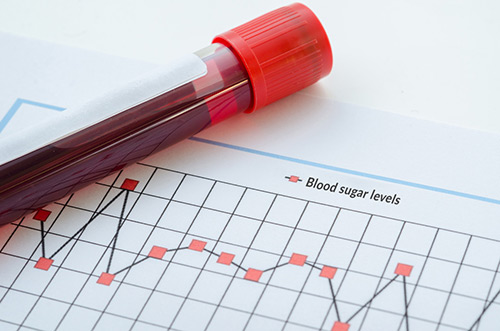Prediabetes – The precursor to type 2 diabetes
Scientific support: Prof. Dr. Robert Wagner
Prediabetes is the precursor to type 2 diabetes. Blood sugar levels are already elevated, though not yet high enough to be classified as type 2 diabetes. It is a metabolic disorder that often develops over years without accompanying symptoms. The risk factors include, among other things, an unhealthy lifestyle. One in five adults has prediabetes.
Long-term elevated blood sugar levels are detrimental to health. If high blood sugar levels are detected late or left untreated, the risk of complications in various organs increases.
Specific lifestyle measures can lower blood sugar levels, reducing the risk of later developing type 2 diabetes.
Researchers propose classifying prediabetes into different subtypes to help identify individuals at high risk for severe outcomes. This allows for highly individualized treatment, which may include medication.

Contents
- What is prediabetes?
- Why does prediabetes occur?
- What symptoms indicate prediabetes?
- What blood sugar or HbA1c levels are considered prediabetes?
- How can you counteract prediabetes without medication?
- Can medication help with prediabetes?
- Can type 2 diabetes be prevented?
- What subtypes of prediabetes are there and what do they mean?
1. What is prediabetes?
Many people have prediabetes without knowing it. If high blood sugar levels remain undetected and untreated for a long time, later complications are very likely. Not only does the risk of type 2 diabetes increase, the elevated blood sugar levels also disrupt many other processes in the body, leading to long-term secondary diseases – such as those affecting the cardiovascular system, eyes, and/or kidneys.
In individuals diagnosed with prediabetes, specific measures can be taken to control it. Simply adjusting diet and increasing physical activity can normalize blood sugar levels. For details on what to consider, read below. Even small lifestyle changes can prevent or at least delay the development of type 2 diabetes and other lifestyle-related diseases.
But what happens if nothing is done after being diagnosed with prediabetes? Then there is a high probability that the metabolic condition will further deteriorate, leading to the development of type 2 diabetes. Type 2 diabetes is typically initially treated with dietary changes and increased physical activity. If these lifestyle measures are insufficient, the administration of blood sugar-lowering medications or insulin becomes necessary.
What is certain is that prediabetes poses a health risk if left untreated. Take the diagnosis as an opportunity to proactively care for your health!
2. Why does prediabetes occur?
Prediabetes occurs when blood sugar levels are consistently elevated in a gray area – but not yet high enough to be considered type 2 diabetes. The body no longer adequately transports sugar (glucose) from the blood into the body's cells. This can be due to either insufficient insulin production (insulin deficiency) or the body's cells becoming less responsive to insulin (insulin resistance).
What does insulin have to do with blood sugar?
Insulin is a hormone produced in the pancreas. It is vital because it ensures that sugar from the blood enters the body's cells. Think of insulin as a key that opens the lock to the body's cells. When something sugary is eaten or drank – for example, bread or juice – the blood sugar level rises within a few minutes. This is completely normal. The pancreas responds to the increased blood sugar by releasing insulin into the bloodstream. Insulin ensures that sugar from the blood is absorbed into the body's cells. Inside the cells, sugar (glucose) is converted into energy, which we need to live.
In the case of insulin resistance, body cells become less sensitive to the hormone insulin. This results in the need for more insulin to transport sugar from the blood into the body's cells. While insulin resistance is a cause of prediabetes in some individuals, others may experience insufficient natural insulin production, also known as insulin deficiency. Consequently, the available insulin is not enough to absorb the sugar into the body's cells. As a result, blood sugar levels remain elevated even hours after eating and when fasting.
Insulin resistance: A vicious circle
When insulin is no longer sufficient to lower blood sugar levels, the body takes notice. In response, the pancreas releases more insulin. Through this mechanism, blood sugar often remains inconspicuous for many years. There are no symptoms.
Studies indicate that the pancreas can initially increase insulin production several-fold. During this time, blood sugar remains within the normal range.
However, the body eventually can't meet the high insulin demand on its own. Only then, often many years or decades later, does insulin become insufficient, leading to elevated blood sugar levels.
Even when insulin production is significantly increased, experts in this case refer to it as relative insulin deficiency. In many cases, insulin resistance is suspected as the cause.
What causes prediabetes?
Prediabetes does not develop overnight, but rather develops over many years. The primary cause of elevated blood sugar levels is an unhealthy lifestyle. The risk of developing metabolic disorders increases if type 2 diabetes is prevalent in close relatives, such as parents. However, other factors also influence the risk.
The following known risk factors for prediabetes are:
- Unhealthy lifestyle
- Lack of physical activity
- Poor diet
- Smoking
- Type 2 diabetes in the family
- Overweight, high blood pressure, poor blood lipid levels
- Gestational diabetes in recent years
- Older age
Since prediabetes is the precursor to type 2 diabetes, the risk factors are identical. Read more about the development and risk factors of type 2 diabetes here.
3. What symptoms indicate prediabetes?
Most people with prediabetes don't experience any symptoms. Symptoms such as excessive thirst, frequent urination, fatigue, and weakness typically manifest only when blood sugar is significantly elevated, which indicates the presence of type 2 diabetes.
In this article you will learn more about the symptoms of type 2 diabetes.
4. What blood sugar or HbA1c levels are considered prediabetes?
Prediabetes manifests itself through elevated blood sugar levels. These can be determined using one of the following methods:
- HbA1c: The long-term blood sugar level provides information about what your blood sugar was on average over the past 8 to 12 weeks. An HbA1c value of 5.7 to 6.4 percent (39 to 47 mmol/mol) indicates prediabetes.
- Fasting blood sugar: This value is determined from the blood of a vein (venous plasma). The person must not have consumed any food or drinks containing sugar for at least 8 hours at the time of the measurement. The measurement takes place in the morning. A fasting blood sugar level of 100 to 125 mg/dl (5.6 to 6.9 mmol/l) indicates prediabetes.
- Oral glucose tolerance test (OGTT): An OGTT tests how well sugar metabolism responds to carbohydrate intake. After consuming a sugar solution on an empty stomach, blood sugar is measured in venous plasma after 2 hours. An OGTT 2-hour blood sugar level of 140 to 199 mg/dl (7.8 to 11.0 mmol/l) indicates prediabetes.
5. How can you counteract prediabetes without medication?
The primary focus of prediabetes treatment is adopting a healthier lifestyle in order to combat the cause of the metabolic disorder. While treating high blood sugar levels with medication is an option, it is typically considered only after a diagnosis of type 2 diabetes and following unsuccessful attempts at treating it with dietary changes and increased physical activity.
When individuals with prediabetes adjust their lifestyle, the risk of developing type 2 diabetes significantly decreases. Lifestyle modifications can improve the body's overall insulin sensitivity, with studies suggesting that changes in diet and increased physical activity are more effective than medications. However, such decisions should always be discussed with a healthcare professional.
Diet for prediabetes
Carbohydrate-containing foods have the most significant impact on blood sugar levels, causing them to rise. Some foods lead to a rapid increase, while others result in a slower elevation of blood sugar. Due to the challenges the body faces in maintaining blood sugar within the normal range during prediabetes, it is advisable to avoid sharp spikes.
Tip 1:
For elevated blood sugar levels, consider a well-rounded, balanced diet. Include vegetables, legumes, whole grains, nuts, seeds, and fruits in your diet. These foods contain ample fiber, which slowly raises blood sugar levels.
Tip 2:
While it's not necessary to completely avoid sugar, it's essential to reduce large quantities. Fruit juices and soft drinks in particular cause blood sugar to rise quickly and sharply. Diluting these drinks with water or substituting with sugar-free alternatives like unsweetened tea can help minimize this rise.
Limit consumption of foods that quickly raise blood sugar levels, such as wheat pasta, white bread, starchy vegetables like potatoes, sweets, sugar-sweetened drinks, honey, and jam.
Tip 3:
Make sure you eat balanced meals with carbohydrates, healthy fats and proteins. When carbohydrates are consumed with protein- or fat-rich foods, the post-meal blood sugar rise is usually less pronounced. For example, consider topping a slice of bread with lean ham or low-fat cheese instead of jam or honey.
“Healthy” fats are found in foods such as fish, plant-based oils (e.g., olive or rapeseed oil), nuts, seeds and avocados. Suitable sources of protein include legumes (e.g., beans, peas and lentils), dairy products, eggs and tuna.
Cooking tip: Less processed foods offer numerous benefits compared to processed and ready-made products (e.g., frozen pizza, spaghetti with ready-made sauce, or purchased fruit yogurt), which often contain added salt, sugar, and unhealthy fats to extend shelf life. They also often contain very little fiber. Therefore, it's advisable to consume foods in their natural form and prepare them at home. By doing so, more valuable nutrients are automatically contained in the food.
A self-prepared yogurt with chopped fruits and nuts, for example, contains more fiber than a store-bought fruit yogurt and keeps you fuller longer. Consider opting for a vegetable stir-fry with whole-wheat pasta instead of spaghetti with ready-made sauce.
You can find more information about a healthy diet here.
Exercise for prediabetes
Physical activity has both short-term and long-term effects on blood sugar levels. In the short term, exercise lowers blood sugar levels. Therefore, according to many studies, incorporating activities like daily walks, participating in exercise classes, or engaging in strength training can demonstrably lower blood sugar levels. Over the long term, regular physical activity enhances the sensitivity of body cells to insulin, reducing the amount of insulin needed to maintain blood sugar within the normal range. It is recommended to aim for at least 150 to 300 minutes of exercise per week.
Tip 4:
Whether it's a bike ride lasting several hours, a 10-minute walk or a Zumba class, the type of physical exercise is irrelevant. The main thing is to move and have fun doing it. Trying out new sports can be rewarding. If you're not fond of going to the gym, online options allow you to participate from the comfort of your home.
Tip 5:
Exploit the blood sugar-lowering effect of exercise. A brief walk after consuming a piece of cake, for instance, can mitigate a significant rise in blood sugar.
Tip 6:
Combining exercise with other tasks is also beneficial. Activities like spring cleaning can boost cardiovascular health. Opting to bike or walk to the grocery store also helps lower blood sugar. Think about what needs to be done and how it can be combined with movement.
Change your lifestyle in the long term
When changing to a healthier lifestyle, the most important thing is to stick with it in the long term. Therefore, try to find a diet that suits your taste and preferences, and incorporate enjoyable physical activities into your routine.
Tip 7:
Seek support; it makes the journey easier. Share your plans with your partner, friends, and acquaintances. It's even better if you embark on the journey together and motivate each other.
Quit smoking
In addition to diet and exercise, tobacco smoking also has a proven impact on blood sugar levels. For this reason, and also because of other possible secondary diseases, both active and passive smoking should be avoided. You can find more information about tobacco and diabetes here.
6. Can medication help with prediabetes?
To date, there is no medication that can combat high blood sugar levels at their origin. However, there are medications available that can support various processes in the body, especially in the context of type 2 diabetes.
Health professionals only prescribe medications when their health benefits outweigh potential risks and side effects. Some people with prediabetes have a higher risk of comorbidities or secondary diseases than others (see subtypes of prediabetes). In such cases, it may be beneficial to take medication even with slightly elevated blood sugar levels. For example, this could help prevent cardiovascular diseases or the progression of prediabetes.
7. Can type 2 diabetes be prevented?
Even though the risk of type 2 diabetes is particularly high in people with prediabetes, it does not necessarily lead to the disease. Studies show that prediabetes can regress. The most effective method is to switch to a healthier lifestyle. This can lead to the normalization of blood sugar levels within a year. The risk of secondary diseases is also reduced if sugar metabolism improves through a healthy diet and increased physical activity.
8. What subtypes of prediabetes are there and what do they mean?
Researchers have found that type 2 diabetes does not progress the same way in all people. Some people have a particularly high risk of diabetes-related secondary diseases, while certain medications may only be effective for others. Researchers therefore suggest classifying people with diabetes into five diabetes subtypes. Six subtypes are currently being discussed for people with prediabetes.
Classifying prediabetes into subtypes could allow an individual approach to prediabetes in the future. This could also identify those people with prediabetes who have a higher risk of later developing type 2 diabetes compared to other people with prediabetes. Targeted therapies could prevent or at least delay the development of further secondary diseases.
There are three subtypes of prediabetes that have a low risk of type 2 diabetes: These are the so-called “clusters” 1, 2 and 4. In contrast, the probability of type 2 diabetes or complications is high among people assigned to clusters 3, 5 or 6.
Individuals with cluster 3 prediabetes have impaired insulin production and type 2 diabetes often runs in the family. This increases the risk of later developing type 2 diabetes. In addition, cardiovascular and kidney diseases often occur in people of this subtype.
People who are assigned to cluster 5, on the other hand, are insulin resistant and have a high liver fat content. Their risk of type 2 diabetes and cardiovascular and kidney diseases is also greatly increased.
People in cluster 6 have a high percentage of abdominal fat. Although the immediate risk of type 2 diabetes is low, they have a high chance of developing kidney disease later on.
Sources:
Ahlqvist, E. et al.: Novel subgroups of adult-onset diabetes and their association with outcomes: a data-driven cluster analysis of six variables. In: Lancet Diabetes Endocrinol, 2018, 6: 361-369
American Diabetes Association: Standards of Medical Care in Diabetes - 2022. In: Clin Diabetes, 2022, 40: 10-38
Bundesärztekammer et al.: Nationale Versorgungsleitlinie Typ-2-Diabetes. Langfassung. Version 3.0. 2023
Bundesärztekammer et al.: Nationale Versorgungsleitlinie Therapie des Typ-2-Diabetes. Langfassung. 1. Auflage. Version 4. 2014 (Gültigkeit abgelaufen, in Überarbeitung)
Chiavaroli, L. et al.: Effect of low glycaemic index or load dietary patterns on glycaemic control and cardiometabolic risk factors in diabetes: systematic review and meta-analysis of randomised controlled trials. In: BMJ, 2021, 374: n1651
Deutsche Diabetes Gesellschaft et al.: Deutscher Gesundheitsbericht Diabetes 2022. Kirchheim Verlag, Mainz, 2021
Deutsches Zentrum für Diabetesforschung e.V.: Subtypen bei Vorstufe des Diabetes entdeckt. (Letzter Abruf: 24.05.2023)
Fritsche, A. et al.: Different Effects of Lifestyle Intervention in High- and Low-Risk Prediabetes: Results of the Randomized Controlled Prediabetes Lifestyle Intervention Study (PLIS). In: Diabetes, 2021, 70: 2785-2795
Galaviz, K. I. et al.: Interventions for reversing prediabetes: A systematic review and meta-analysis. In: Am J Prev Med, 2022, 62: 614-625
MacLeod, S. F. et al.: Exercise lowers postprandial glucose but not fasting glucose in type 2 diabetes: a meta-analysis of studies using continuous glucose monitoring. In: Diabetes Metab Res Rev, 2013, 29: 593-603
Pasmans, K. et al.: Nutritional strategies to attenuate postprandial glycemic response. In: Obes Rev, 2022, 23: e13486
Schleicher, E. et al.: Definition, Klassifikation und Diagnostik des Diabetes mellitus: Update 2021. In: Diabetologe, 2022, 18: 41-48
Schlesinger, S. et al.: Prediabetes and risk of mortality, diabetes-related complications and comorbidities: umbrella review of meta-analyses of prospective studies. In: Diabetologia, 2022, 65: 275-285
Wagner, R. et al.: Pathophysiology-based subphenotyping of individuals at elevated risk for type 2 diabetes. In: Nature Medicine, 2021, 27: 49-57
Zaharia, O. P. et al.: Risk of diabetes-associated diseases in subgroups of patients with recent-onset diabetes: a 5-year follow-up study. In: Lancet Diabetes Endocrinol, 2019, 7: 684-694
As of: 24.05.2023




